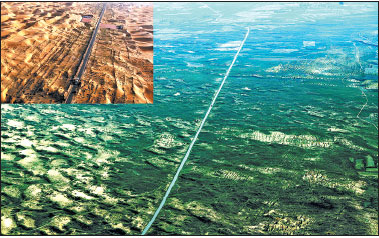Kubuqi desert turns over a new leaf, as planting program blossoms
The Kubuqi, China's seventh largest desert, is turning into a land of green - after years of effort and innovation using desertification control methods.
Located to the north of the ridge of the Ordos plateau, the Kubuqi desert covers an area of 186 million hectares.
It had been infamous once for being a seemingly lifeless dust bowl. After 28 years of controlling the desertification, as well as seeding and planting, now a quarter of the former wasteland has become home to thriving trees and undergrowth.
Wang Wenbiao, owner of Elion Resources Group, was born in Nao'er village, Hanggin Banner in Inner Mongolia autonomous region.
"My childhood memories were haunted by sand," the 58-year-old said.
"When I ate, I tasted sand. When I went to bed, I slept on sand. When I breathed, I inhaled sand."
Wang said his dream was to go out of the desert and eat a meal without sand in the food.
In 1997, Wang's company Elion cooperated with the local government to build roads in the desert. To date, they've built five expressways stretching 343 kilometers, connecting Kubuqi to the outside world. The expressways are all lined with trees.
Lin Fawang, a retiree from an afforestation plant in the city of Ordos, started his battle against desertification after his retirement in 1993, when he was in his sixties.
In Xuhaitu village, Dalad Banner, in the middle of Kubuqi, Lin stepped in to protect his home from being devoured by the sand.
"The thought of the desert becoming an oasis gave me a thrill," Lin said. "I was so excited by the idea that I couldn't get any sleep because I felt I must do something."
Lin moved into the heart of desert with his wife and over the past decade they planted trees every spring. What he has done has encouraged more and more villagers to get involved in the anti-desertification cause.
Over the years, anti-desertification methods have become more and more advanced and systematic, with the local government's help.
One of the desert control methods is to plant licorice plants in a square patch, to prevent the sand inside the square from flying away on windy days. The licorice, grown under the strong desert sunshine, also provides extra income for the locals.
"We say Kubuqi licorice is the best because it's red while the other licorice is black," said Wu Zhihua, a local resident aged 60, who earns 6,000 yuan ($900) a month from her licorice plot.
Another way of taming and harnessing the desert involves adapting photovoltatic technology. The Kubuqi has more than 3,180 hours of sunshine in a year, which makes it an ideal spot to install solar power farms.
The locals have installed photovoltatic generators to produce electricity, while the shade underneath the generators provides space for undergrowth. The grass growing under the generators can also be used to feed the animals, such as sheep and chickens.
The local government also built a seed museum to preserve the diversity of plant life grown in the region. The seed museum has collected more than 1,040 types of seeds that can grow in dry, cold and salt laden land.
Since 2010, the government has invested over 1.16 billion yuan in controlling and greening the desert. So far it has planted over 6.77 million plants of various types.
By the end of 2016, 26.7 percent of Ordos had been covered by forests and 75 percent covered by various plants, up 14.54 percent and 40 percent respectively from 2010.
Due to its significant outcome, the Kubuqi desertification control model was named by the United Nations as a "global ecological and economic demonstration zone" in 2014.
The United Nations Environment Program released a report in 2015 at a climate conference that year in Paris, recognizing the success of the Kubuqi desert's desertification controls.
The area has held a Kubuqi International Desert Forum every two years since 2007.
The latest forum was held in July this year, and the theme was "Greening the Belt and Road, Sharing the Desert Economy".
renxiaojin@chinadaily.com.cn
|
|



















